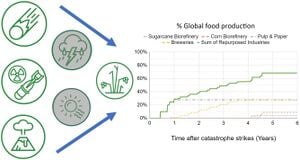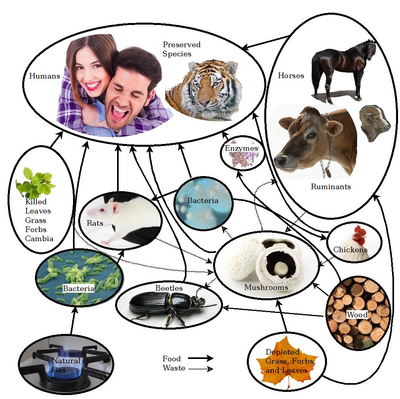
Producing sugar from lignocellulosic biomass is a promising resilient food solution to counter the near-total global failure of food production due to the agricultural collapse that would likely follow an abrupt sunlight reduction catastrophe such as a nuclear winter, a supervolcanic eruption, or a large asteroid or comet impact.
This study examines how quickly edible sugar production could be ramped up globally by repurposing pulp and paper mills, sugarcane biorefineries, corn biorefineries, and breweries for lignocellulosic sugar production. A sub-unit component comparison to the NREL 2017 Biochemical Sugar Model indicates that 61%, 62%, 85% and 38% of ISBL unit components are present, respectively. Fast construction methods were studied to analyze how this and other industrial foods could be rapidly leveraged in a catastrophe.
Results suggest that the world's current sugar demand could quickly be fulfilled by repurposing pulp and paper mills for lignocellulosic sugar production, given 5 months of production ramp-up and 24/7 construction. This method could reduce construction time to an estimated 32% of the original at an increased labor cost of 1.47 times, resulting in sugar production beginning 5 months after the catastrophe at a retail cost of $0.82 USD/kg. This could not only contribute a significant share of the food requirement after the catastrophe (∼28% within the first year), but also be key to preventing global starvation between the time at which global food storages run dry and other resilient food solutions can scale up significantly.
This study aims to serve as the basis for more comprehensive scenario analyses. More research is needed to characterize material and labor constraints to fast response in more depth; repurposing and fast construction pilot studies and food safety studies are recommended.
Highlights[edit | edit source]
- Existing infrastructure was assessed for repurposing to lignocellulosic sugar production.
- Pulp & paper factories showed 85% component match with the NSM reference plant.
- Lignocellulosic sugar could fulfill the global sugar demand in 5 months after catastrophe strikes.
- The cost of sugar produced this way is estimated at $0.82/kg in the nuclear winter scenario.
- Factory construction time can be reduced to 32% for a 1.47 times increase in labor cost.
See also[edit | edit source]

- Feeding Everyone No Matter What - The full book main page
- David Denkenberger and Joshua Pearce, Feeding Everyone No Matter What: Managing Food Security After Global Catastrophe , 1st Edition, Academic Press, 2015
- Free Preview: Google books
- Cover on Academia
- Facebook page
- Alternative Foods as a Solution to Global Food Supply Catastrophes
- Resilience to global food supply catastrophes
- Feeding Everyone if the Sun is Obscured and Industry is Disabled
- Cost-Effectiveness of Interventions for Alternate Food to Address Agricultural Catastrophes Globally
- Feeding Everyone: Solving the Food Crisis in Event of Global Catastrophes that Kill Crops or Obscure the Sun
- Food without sun: Price and life-saving potential
- Cost-effectiveness of interventions for alternate food in the United States to address agricultural catastrophes
- Micronutrient Availability in Alternative Foods During Agricultural Catastrophes
- Preliminary Automated Determination of Edibility of Alternative Foods: Non-Targeted Screening for Toxins in Red Maple Leaf Concentrate
- Open Source Software Toolchain for Automated Non-Targeted Screening for Toxins in Alternative Foods
- Scaling of greenhouse crop production in low sunlight scenarios
- Potential of microbial protein from hydrogen for preventing mass starvation in catastrophic scenarios
- U.S. Potential of Sustainable Backyard Distributed Animal and Plant Protein Production During & After Pandemics
- Global distribution of forest classes and leaf biomass for use as alternative foods to minimize malnutrition
- Long-term cost-effectiveness of interventions for loss of electricity/industry compared to artificial general intelligence safety
- Long term cost-effectiveness of resilient foods for global catastrophes compared to artificial general intelligence safety
- Rapid repurposing of pulp and paper mills, biorefineries, and breweries for lignocellulosic sugar production in global food catastrophes
- Nutrition in Abrupt Sunlight Reduction Scenarios: Envisioning Feasible Balanced Diets on Resilient Foods
- Methane Single Cell Protein: securing protein supply during global food catastrophes
- Killing two birds with one stone: chemical and biological upcycling of polyethylene terephthalate plastics into food
- How Easy is it to Feed Everyone? Economic Alternatives to Eliminate Human Nutrition Deficits
- Quantifying Alternative Food Potential of Agricultural Residue in Rural Communities of Sub-Saharan Africa
- Yield and Toxin Analysis of Leaf Protein Concentrate from Common North American Coniferous Trees
- Toxic Analysis of Leaf Protein Concentrate Regarding Common Agricultural Residues
- Towards Sustainable Protein Sources: The Thermal and Rheological Properties of Alternative Proteins
Additional Information[edit source]
- ALLFED
- Dave Denkenberger Publications
- OSE Wiki "Synfood" (i.e. protein and other dietary components from microbial organisms fed on gas or other hydrocarbons)





